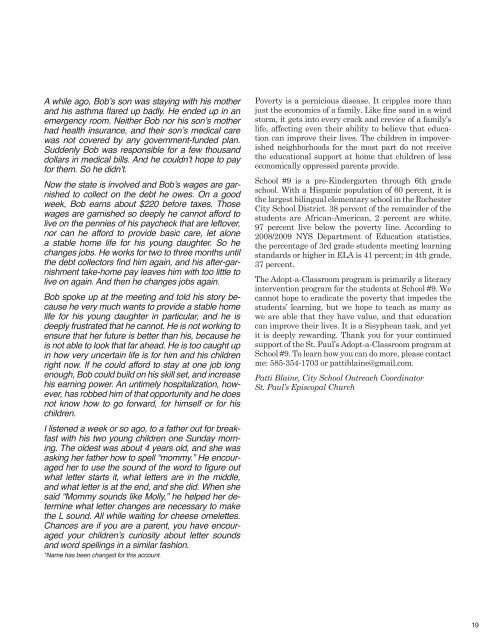a publication of the episcopal diocese of rochester, ny
a publication of the episcopal diocese of rochester, ny
a publication of the episcopal diocese of rochester, ny
- No tags were found...
You also want an ePaper? Increase the reach of your titles
YUMPU automatically turns print PDFs into web optimized ePapers that Google loves.
A while ago, Bob’s son was staying with his mo<strong>the</strong>rand his asthma flared up badly. He ended up in anemergency room. Nei<strong>the</strong>r Bob nor his son’s mo<strong>the</strong>rhad health insurance, and <strong>the</strong>ir son’s medical carewas not covered by a<strong>ny</strong> government-funded plan.Suddenly Bob was responsible for a few thousanddollars in medical bills. And he couldn’t hope to payfor <strong>the</strong>m. So he didn’t.Now <strong>the</strong> state is involved and Bob’s wages are garnishedto collect on <strong>the</strong> debt he owes. On a goodweek, Bob earns about $220 before taxes. Thosewages are garnished so deeply he cannot afford tolive on <strong>the</strong> pennies <strong>of</strong> his paycheck that are leftover,nor can he afford to provide basic care, let alonea stable home life for his young daughter. So hechanges jobs. He works for two to three months until<strong>the</strong> debt collectors find him again, and his after-garnishmenttake-home pay leaves him with too little tolive on again. And <strong>the</strong>n he changes jobs again.Bob spoke up at <strong>the</strong> meeting and told his story becausehe very much wants to provide a stable homelife for his young daughter in particular, and he isdeeply frustrated that he cannot. He is not working toensure that her future is better than his, because heis not able to look that far ahead. He is too caught upin how very uncertain life is for him and his childrenright now. If he could afford to stay at one job longenough, Bob could build on his skill set, and increasehis earning power. An untimely hospitalization, however,has robbed him <strong>of</strong> that opportunity and he doesnot know how to go forward, for himself or for hischildren.I listened a week or so ago, to a fa<strong>the</strong>r out for breakfastwith his two young children one Sunday morning.The oldest was about 4 years old, and she wasasking her fa<strong>the</strong>r how to spell “mommy.” He encouragedher to use <strong>the</strong> sound <strong>of</strong> <strong>the</strong> word to figure outwhat letter starts it, what letters are in <strong>the</strong> middle,and what letter is at <strong>the</strong> end, and she did. When shesaid “Mommy sounds like Molly,” he helped her determinewhat letter changes are necessary to make<strong>the</strong> L sound. All while waiting for cheese omelettes.Chances are if you are a parent, you have encouragedyour children’s curiosity about letter soundsand word spellings in a similar fashion.*Name has been changed for this account.Poverty is a pernicious disease. It cripples more thanjust <strong>the</strong> economics <strong>of</strong> a family. Like fine sand in a windstorm, it gets into every crack and crevice <strong>of</strong> a family’slife, affecting even <strong>the</strong>ir ability to believe that educationcan improve <strong>the</strong>ir lives. The children in impoverishedneighborhoods for <strong>the</strong> most part do not receive<strong>the</strong> educational support at home that children <strong>of</strong> lesseconomically oppressed parents provide.School #9 is a pre-Kindergarten through 6th gradeschool. With a Hispanic population <strong>of</strong> 60 percent, it is<strong>the</strong> largest bilingual elementary school in <strong>the</strong> RochesterCity School District. 38 percent <strong>of</strong> <strong>the</strong> remainder <strong>of</strong> <strong>the</strong>students are African-American, 2 percent are white.97 percent live below <strong>the</strong> poverty line. According to2008/2009 NYS Department <strong>of</strong> Education statistics,<strong>the</strong> percentage <strong>of</strong> 3rd grade students meeting learningstandards or higher in ELA is 41 percent; in 4th grade,37 percent.The Adopt-a-Classroom program is primarily a literacyintervention program for <strong>the</strong> students at School #9. Wecannot hope to eradicate <strong>the</strong> poverty that impedes <strong>the</strong>students’ learning, but we hope to teach as ma<strong>ny</strong> aswe are able that <strong>the</strong>y have value, and that educationcan improve <strong>the</strong>ir lives. It is a Sisyphean task, and yetit is deeply rewarding. Thank you for your continuedsupport <strong>of</strong> <strong>the</strong> St. Paul’s Adopt-a-Classroom program atSchool #9. To learn how you can do more, please contactme: 585-354-1703 or pattiblaine@gmail.com.Patti Blaine, City School Outreach CoordinatorSt. Paul’s Episcopal Church19




